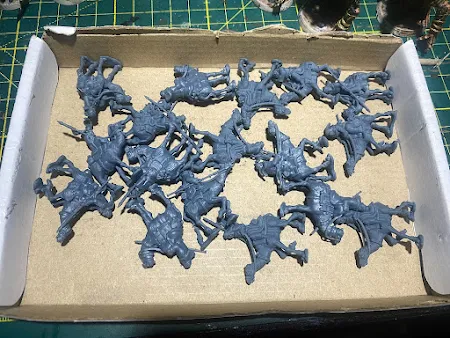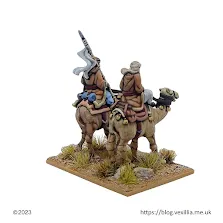We've all done it!. Bought something on impulse that is. In my case I bought the Arab Conquest Army Deal from Red Copper for a mere 30€. The deal includes both 15 & 28 mm versions.
I want to make it clear that I do not own a 3D printer nor do I intend to go down that route due to lack of space in my new home. This makes the purchase seem somewhat less than sensible, but I do think 3D printing is the way forward. Somehow, I managed to convince myself this would be a sensible medium term investment.
I also want to admit that I have no need for most of the figures having recently finished a metal Arab Conquest army. As such, this purchase represents the apogee of "wargamers' madness", or the "ooh shiny syndrome". As the addicts say "my name is Martin and I'm a wargamer".
All joking aside, I was really curious to see if, in 15 mm, the figures would be as good as the computer renders (above) when it came to painting them (see below). I have seen reviews of some 15 mm 3D prints that mentioned shallow details and resultant difficulty painting.
So why buy?
Firstly, the files weren't that expensive; not that much more than a few
sample packs of metal figures. Plus there are parts of the deal that I
may use in the future. In particular the named commanders, camp items,
civilians and swordsmen.
However, The thing that really drew me in was the above photo (amongst others) of painted 15 mm camel riders. I've been looking for some decent camel riders for sometime without much success.
After all how difficult would it be to find someone with a resin printer willing to help a friend? In the end one of my recent ADLG opponents, Graeme Carroll, offered to print a few camel riders for me as a favour. Thanks Graeme.
Initial reaction & issues
Prior to receiving these figures I'd only ever painted
one resin model
so I had no idea what to expect. I was sent a photo (below) of the
prints prior to posting. They looked good and I was keen to see them "in
the resin". I also wanted to see how they compared to my Forged in
Battle (FiB) figures.
When the figures arrived I was pleased to see that the figures were superb! They were even better than the photograph. The sculpting is excellent with lots of clear details. All the poses look great and are well animated. They fit well with both my Essex & FiB figures.
Unfortunately, the batch was not without issues:
- When the models arrived in the post, I found that quite a few had broken lance ends, or one of the reins had been crushed in transit. I'd originally arranged for these to be handed over at a competition but the arrangements fell through. I've learnt my lesson: no more post.
- I was able to rescue one figure using superglue but only because the break was such that there was enough surface area to ensure a strong bond. In general, broken lances are far too thin to repair; I assume they are robust enough in 28 mm but they are just too thin in 15 mm.
Given this, I'm a slightly worried about the lances' durability during games. So, I've decided to base the figures with all the lances on the inside. This should reduce the risk of breakages, but only time will tell.
Rescue tip
One surprising advantage of these 3D prints is it's relatively easy to remove
certain parts of the sculpts with a sharp blade.
Because of this, I was able to "rescue" a further two figures by removing all of the broken lances (and reins on two figures). They simply "pop" off if pressure is applied in the right way. The lances look to be printed with minimal contact with the body; attached but not in the same way as a metal model.
Painted samples
Painting notes
- These figures were a joy to paint. They were so good I started using a new brush to get the best out of the details.
- I usually use hot glue to attach metal models to an upturned Humbrol tin which acts as handle during painting. The resin models felt too fragile for this method so, for the first time, I switched to Blu Tack. The model was a bit wobbly during priming but was perfectly stable during painting.
- Priming with my usual large brush wasn't ideal. I had to switch to a much smaller brush to work the primer into the depths of the model; there are so many undercuts and deep recesses (all very realistic) that require extra attention. I can understand why people might prefer an aerosol primer for complex 3D prints.
- The riders are well sculpted with both sharp and smooth folds that are easy to pick out. All the details sit proud making them really easy to paint. Things like cloth trim and camel furniture are a doddle.
- The camels have well defined muscles and joints. The camels' faces are excellent and rewards extra effort. The tassels on the camels' saddles are so well defined I painted them really quickly.
- Finally, I used a wash on one of the camels, mainly to tone down the colour as I'd over highlighted the coat, and was pleasantly surprised just how much extra detail the wash picked out.
Basing notes
- I based the first figures on a metal base to give them some extra weight and to allow them to be easily transported in a magnetised Really Useful Box. Time will tell if this works and is robust enough during play.
- After I'd based the figures, I realised they had a very slight lean. Next time I'll put a thin card wedge under one side to level the figures up.
Closing remarks
As a low cost experiment I think this was a major success. Fragility in
the post aside, the figures are a joy to work with and painting is a real
pleasure. In real life, well 15 mm scale, the prints live up to the
promise of the computer renders.
I look forward to finishing all the camels I need for my Arab armies and buying the next release from Red Copper.
.png)








No comments:
Post a Comment
Comments are always welcome but this blog no longer accepts anonymous comments.